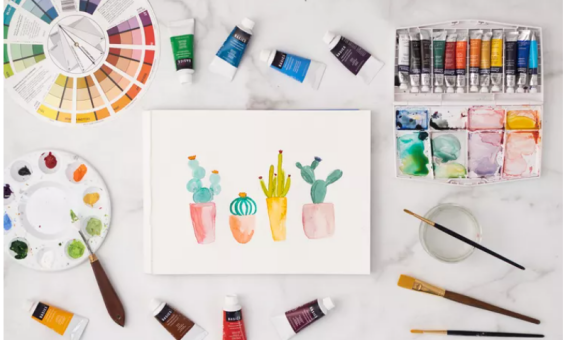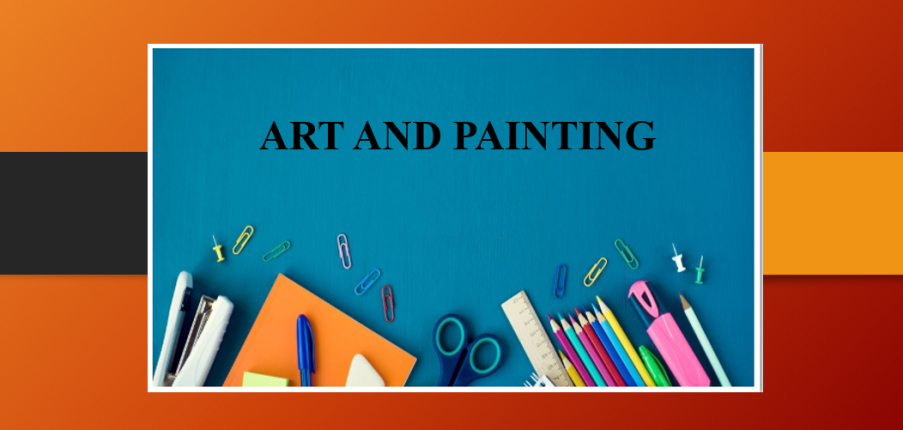Topic: Art and Painting | Bài mẫu + Từ vựng IELTS Speaking part 1, 2, 3
Bài mẫu topic Art and Painting IELTS Speaking part 1

1. Do you like art?
To be honest, I do have a soft spot for art. I cannot say that I’m a skillful painter or anything, but I do draw every now and then. When I was younger I didn’t really know how to define art, but it grew on me and now I can even create some one-of-a-kind artworks for house decoration.
- Have a soft spot for something: yêu thích
- Every now and then: thi thoảng
- Grow on me: (niềm yêu thích) dần lớn lên trong tôi
2. What kind of paintings do people like?
From my observation, most people enjoy hanging pictures of natural landscapes on the walls of their homes. Looking at the spectacular views of rocky mountains, or the breezy and sparkling river flow, can create a sense of well-being and peacefulness. Others, however, are more into portraits, whether of themselves or their beloved ones.
- From my observation: theo tôi thấy
- Spectacular: hùng vĩ
- Sense of well-being: cảm giác hạnh phúc
- Breezy: mát mẻ
- Sparkling: lấp lánh
- Peacefulness: sự bình yên
3. What benefits can you get from painting as a hobby?
I learned that there are some psychological effects colors might have on our emotions. By saying this, I mean it can uplift my mood only by mixing and playing with different shades of red, yellow, green or blue. And painting has been extremely useful in helping me to increase my attention span, you know, because it often takes days or even months to finish a proper drawing.
- Psychological effects: hiệu ứng tâm lý
- Uplift one’s mood: làm ai vui lên
- Increase one’s attention span: tăng khả năng tập trung
4. Is it easy to learn how to draw?
No, I wouldn’t say that. In fact, it is a tough nut to crack for most people. Unless you have an inborn talent for art, or have a long-term commitment to art and wish to pursue it as your life-long career, I don’t think it is easy to create aesthetically pleasing works of art.
- A tough nut to crack: một vấn đề khó
- Inborn talent: tài năng thiên bẩm
- Aesthetically pleasing: đẹp, mang tính nghệ thuật
- Work of art: tác phẩm nghệ thuật
Bài mẫu IELTS Speaking part 2: Describe an art gallery that you visited
Đề bài
IELTS Speaking Part 2: Describe an art gallery that you visited.
You should say:
- When you saw this exhibition
- Where it was held
- What was on display
And explain your impression of the exhibition.
Bài mẫu
I would like to talk about the time I visited an interactive (1) art gallery. Last year’s spring break I had some time to spare so I asked my friends out and after a bit of thought (2), we decided to visit the Artinus 3D Art Museum, which was located in a secluded area (3) of district 7. This place was known to be one of the first 3D art exhibitions in HCM city, displaying (4) hundreds of illusion artworks created by exceptional Korean artists.
As for what was on display, there was a wide range of 3D paintings in various colors. The categories spread from the wildlife world, ancient Egypt, Renaissance art to natural landscapes. But what made the place distinctively different from others was the excellent use of perspective figures (5) to create such mind-blowing (6) optical illusion (7) so that visitors can step inside the artworks and be part of the stunning 3D scenes.
From being trapped in a small bottle of water, floating on the big ocean to fighting dragons, every inch of the oil paintings was amazingly realistic (8). We were thrilled to bits (9) to lay our eyes on (10) the artworks and took some amazing photos of us interacting with them. We even held a small competition of whoever came up with (11) the funniest postures with the paintings, winning a prize of 500 thousand dong.
It was truly an out-of-this-world (12) experience for all of us, since we could see all the paintings brought to life. With an affordable (13) entrance fee of $9 – $13, I think the Artinus 3D Art Museum is suitable for all ages, who wish to seek a place to appreciate the extraordinary artworks, as well as to spend some quality time with their friends and families.
Từ vựng
- (1) Interactive (adj): có tính tương tác
- (2) A bit of thought (n): một hồi suy nghĩ
- (3) Secluded (adj): riêng tư, tách biệt
- (4) Display (n), (v): trưng bày
- (5) Perspective figures (n): luật phối cảnh
- (6) Mind-blowing (adj) : gây ảo giác
- (7) Optical illusion (n): ảo ảnh
- (8) Realistic (adj): chân thật
- (9) Thrilled (to bits) (adj): vô cùng hào hứng
- (10)Lay our eyes on s.th/ s.o: nhìn thấy gì đó/ ai đó lần đầu tiên
- (11)Came up with: nghĩ ra
- (12)Out-of-this-world (adj): ngoài sức tưởng tượng
- (13)Affordable (adj): (giá) hợp lý
Bài mẫu IELTS Speaking part 3 topic Art
1. Do you think art classes are necessary? (Why?)/ How do you think art classes affect children’s development?
Well, I do think having art classes is a must in school’s curriculums. As I can see, most children take pleasure in drawing and coloring as they gravitate towards things that are full of colors. Drawing isn’t just a way for children to let off some steam after struggling with heavy school work, but it also enables them to fire their imagination, thus improving their cognitive development. When most children today are cast into the same mold, it is even more crucial to encouraging them to think outside of the box and put those brilliant ideas down on paper.
- Take pleasure in: thích thú
- Gravitate toward: nghiêng về
- Let off some steam: xả hơi, thư giãn
- Struggle: vật lộn, cố gắng
- Cognitive development: sự phát triển về nhận thức
- Cast into the same mold: bị gò ép vào khuôn khổ
- Think outside of the box: tư duy đột phá
2. What are some traditional art forms in your country?
Regarding picture drawing, silk painting can be considered to be one of the most widely-known forms of art in Vietnam. These unique artworks on silk canvas have been around for thousands of years and are of immense traditional and aesthetic value. But that is not it. Vietnam is also known for other forms of art such as pottery, calligraphy, sculpture and traditional music, a lot of which have been recognized as the world’s Intangible Cultural Heritage by UNESCO.
- Silk painting: vẽ tranh lụa
- Widely-known: được biết đến rộng rãi
- Silk canvas: tấm lụa
- Be around: có mặt, tồn tại
- Immense: to lớn
- Aesthetic value: rất giàu giá trị nghệ thuật
- Intangible cultural heritage: di sản văn hoá phi vật thể
3. What makes a good painting?
As the saying goes, beauty is in the eye of the beholder, meaning that not everyone has the same definition of what is beautiful and what is not. However, I believe there are things all the greatest masterpieces have in common. To me, what makes the success of a painting is that its composition, color, and subject matter all work in accordance with one another to deliver a consolidated and well-executed artwork. As long as it can interpret the artists’ ideas, I believe it is a beautiful work of art.
- Masterpiece (n): kiệt tác
- Composition (n): cấu tạo
- Subject matter (n): chủ thể
- Well-executed (adj): thể hiện tốt
- Interpret (v): dịch ra
4. How has art changed in the last few decades in your country?
I have to admit that I am no art expert, but as far I can understand, there have been a few changes in all forms of art in my country. A few decades ago, any artwork, be it a theater performance, a painting work, a film or a song, often avoided bearing any complex meaning which possibly reflected the social affairs. Those artworks were often considered too “thought-provoking” and even inappropriate to the early generations. However, now that everyone is more open-minded, messages about intimacy, gender equality or politics through contemporary art are no longer elusive.
- Reflect (v): phản ánh
- Social affairs (n):
- Thought-provoking (adj): gây khơi gợi ý nghĩ
- Inappropriate (adj): không phù hợp
- Intimacy (adj): tình cảm, sự thân mật
- Gender equality (n): bình đẳng giới
- Elusive (adj): lu mờ, bị che giấu
Xem thêm các tài liệu Tiếng Anh hay, chi tiết khác:
TOP Việc làm "HOT" dành cho sinh viên:




